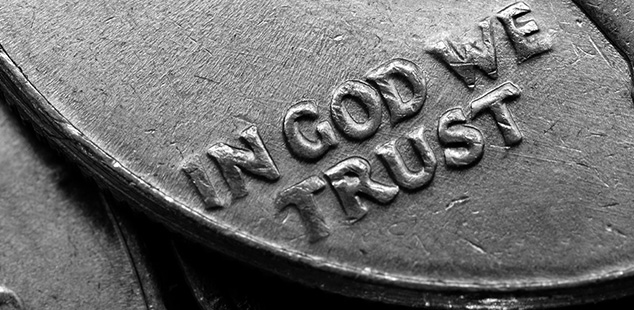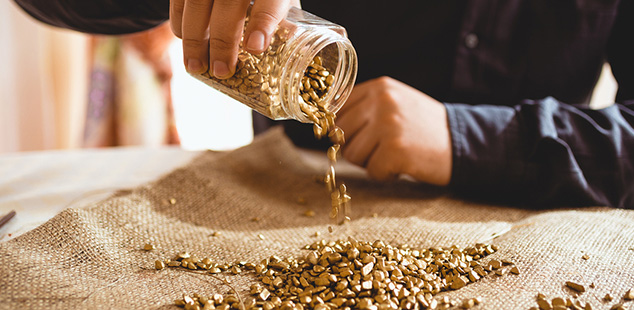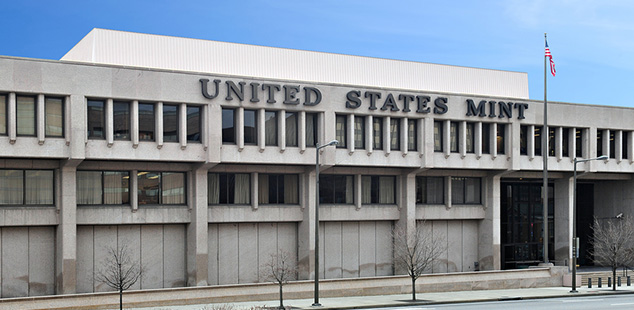
For over 200 years, the U.S. Mint has supplied the country with coins and notes. Like many other aspects of our history, it started with a rather unique twist.
One of the great ironies of political policy will take place when the Department of the Treasury removes Alexander Hamilton as the main subject of the ten-dollar bill, despite the Founding Father pushing harder than any other politician in US history to create a national banking system. The story of Hamilton’s removal (though perhaps he will return to the $1,000 bill as he did during the 19th century, despite the scarcity of this large-denomination bill) ties in neatly to the founding of the United States Mint and the history of gold itself. Read on for a glimpse into the fascinating history of the U.S. Mint.
Origin of American Coinage
In the aftermath of the American Revolution, the federal government had no central bank. Each state under the Articles of Confederation minted their own money, and this lead to currency imbalances and trade disputes between each state. For instance, since no federal commission existed to determine how much a South Carolina dollar could purchase relative to a Pennsylvania dollar, each state could artificially increase the value of their cash through distribution or by setting up tariffs that made it more expensive to sell goods from out-of-state or buy gold.
With the dissolution of the Articles of Confederation and the creation of the U.S. Constitution, the federal government took control of the national currency in 1792. The government set out printing money in order to pay the bills as quickly as possible. The first director of the Philadelphia Mint, David Rittenhouse, volunteered $75 of his own silver to pump out the coinage at a time when a dollar would purchase about a week’s rent; George Washington also donated personal funds to the cause 1.
Some of the earliest American coins look decidedly unfamiliar to modern eyes: the 1792 half-disme piece made of four fifths silver features Lady Liberty rather than a Founding Father and reads “Liberty Parent of Science and Industry,” while the eagle on the reverse clutches neither arrows nor olive branches.
Minting During the Civil War
As the thirteen colonies expanded into more and more states, the government began setting up new mints, and established two in North Carolina and New Orleans in 1838. Only the Philadelphia Mint produced copper and silver coins, while the southern mints produced only gold. This proved advantageous to the Union during the Civil War, for the ability to mint coins of smaller denomination stabilized the Union dollar, while the Confederate dollar experienced hyperinflation due to a failure to circulate small-value coins.
By 1862, both the Union and the Confederacy began printing paper money as a substitute for precious metals. Without metal to back up their money or any capability for buying gold, however, the Confederacy’s inflation spiraled further out of control: a pair of shoes that cost one dollar at the start of the war would cost almost one hundred dollars by the war’s conclusion. Not until the end of Reconstruction did the federal government permit the southern mints to start creating new currency.
The Gold Rushes

With the discovery of California gold in 1848 came a massive migration westward. Other gold rushes in Colorado, Montana, North Dakota, and Alaska, coupled with the discovery of silver in Utah and Nevada, necessitated new western mints that could circulate currency and control the metals market. Only six years after Nevada’s statehood came the Carson City Mint, but the end of the Nevada silver boom in the late 1800s forced the closure of this mint. This makes the Carson City coins, like a 1889 silver dollar, especially valuable for collectors: an authentic, good-condition silver dollar from the Nevada mint can fetch anywhere from one to five hundred dollars.
The Denver Mint, constructed in 1903, still serves as the nexus point for all American currency produced west of the Mississippi River. Due to the various precious metal rushes around the country, the Denver Mint took in about five million dollars of gold and silver per year by the turn of the 20th century. The San Francisco Mint managed to survive the great earthquake of 1908 but was re-purposed to serve only for proof currency rather than mass production.
Changing Gold Standards

As the United States dropped the gold standard of the 1970s, the Treasury needed something to do with its collection of gold on hand. The production of the American Eagle gold coin in 1985 created new gold coins and began to influence the price of gold by driving demand upwards and upwards. The gold eagle proved less than popular in the public, but became a valuable keepsake for the Federal Reserve and precious metals IRA portfolios. These gold coins are only3 90% gold today; the rest of the coin is a mix of silver and copper. Most of the gold produced by today’s mint, in fact, never ends up in circulation, despite the fact that gold dollar coins can be used for all debts both public and private, much like the fifty-cent piece or the two-dollar bill. Rather, many of these gold coins end up in investor portfolios because individual collectors and investors recognize the long-term value of owning gold.
Additional Sources:
1 – https://www.usmint.gov/education/historianscorner/?action=history


